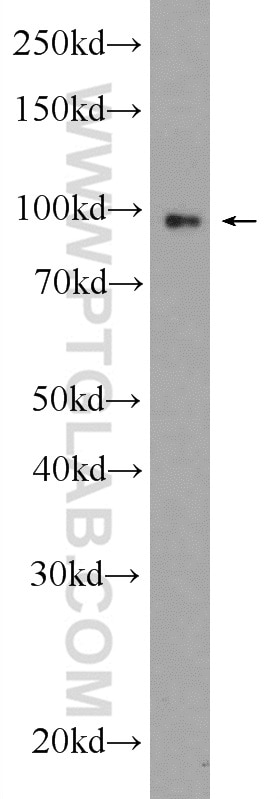Anticorps Polyclonal de lapin anti-Transportin-1
Transportin-1 Polyclonal Antibody for WB, ELISA
Hôte / Isotype
Lapin / IgG
Réactivité testée
Humain, souris
Applications
WB, IF, ELISA
Conjugaison
Non conjugué
N° de cat : 20679-1-AP
Synonymes
Galerie de données de validation
Applications testées
| Résultats positifs en WB | cellules HeLa, cellules HEK-293, cellules L02, tissu hépatique de souris |
Dilution recommandée
| Application | Dilution |
|---|---|
| Western Blot (WB) | WB : 1:200-1:1000 |
| It is recommended that this reagent should be titrated in each testing system to obtain optimal results. | |
| Sample-dependent, check data in validation data gallery | |
Applications publiées
| WB | See 2 publications below |
| IF | See 3 publications below |
Informations sur le produit
20679-1-AP cible Transportin-1 dans les applications de WB, IF, ELISA et montre une réactivité avec des échantillons Humain, souris
| Réactivité | Humain, souris |
| Réactivité citée | Humain |
| Hôte / Isotype | Lapin / IgG |
| Clonalité | Polyclonal |
| Type | Anticorps |
| Immunogène | Peptide |
| Nom complet | transportin 1 |
| Masse moléculaire calculée | 102 kDa |
| Poids moléculaire observé | 102 kDa |
| Numéro d’acquisition GenBank | NM_002270 |
| Symbole du gène | Transportin-1 |
| Identification du gène (NCBI) | 3842 |
| Conjugaison | Non conjugué |
| Forme | Liquide |
| Méthode de purification | Purification par affinité contre l'antigène |
| Tampon de stockage | PBS avec azoture de sodium à 0,02 % et glycérol à 50 % pH 7,3 |
| Conditions de stockage | Stocker à -20°C. Stable pendant un an après l'expédition. L'aliquotage n'est pas nécessaire pour le stockage à -20oC Les 20ul contiennent 0,1% de BSA. |
Informations générales
TNPO1, also named as KPNB2, MIP1, TRN and MIP, belongs to the importin beta family. TNPO1 functions in nuclear protein import as nuclear transport receptor. It serves as receptor for nuclear localization signals (NLS) in cargo substrates. TNPO1 is thought to mediate docking of the importin/substrate complex to the nuclear pore complex (NPC) through binding to nucleoporin and the complex is subsequently translocated through the pore by an energy requiring, Ran-dependent mechanism. At the nucleoplasmic side of the NPC, Ran binds to the importin, the importin/substrate complex dissociates and importin is re-exported from the nucleus to the cytoplasm where GTP hydrolysis releases Ran. The directionality of nuclear import is thought to be conferred by an asymmetric distribution of the GTP- and GDP-bound forms of Ran between the cytoplasm and nucleus. TNPO1 is involved in nuclear import of M9-containing proteins. In vitro, it binds directly to the M9 region of the heterogeneous nuclear ribonucleoproteins (hnRNP), A1 and A2 and mediates their nuclear import. It is involved in hnRNP A1/A2 nuclear export. TNPO1 mediates the nuclear import of ribosomal proteins RPL23A, RPS7 and RPL5. It binds to a beta-like import receptor binding (BIB) domain of RPL23A. In vitro, it mediates nuclear import of H2A, H2B, H3 and H4 histones, and SRP19. In case of HIV-1 infection, binds and mediates the nuclear import of HIV-1 Rev. The antibody is specific to TNPO1.
Protocole
| Product Specific Protocols | |
|---|---|
| WB protocol for Transportin-1 antibody 20679-1-AP | Download protocol |
| Standard Protocols | |
|---|---|
| Click here to view our Standard Protocols |
Publications
| Species | Application | Title |
|---|---|---|
Sci Rep Nuclear RNA transcript levels modulate nucleocytoplasmic distribution of ALS/FTD-associated protein FUS. | ||
Cell Rep Antiviral Immune Response as a Trigger of FUS Proteinopathy in Amyotrophic Lateral Sclerosis. | ||
Small Effects of Puerarin-Loaded Tetrahedral Framework Nucleic Acids on Osteonecrosis of the Femoral Head |
Avis
The reviews below have been submitted by verified Proteintech customers who received an incentive forproviding their feedback.
FH María (Verified Customer) (02-08-2022) | Works good for WB (1:1000). For IF, some background but works ok (1:100)
|





